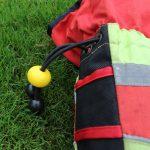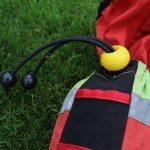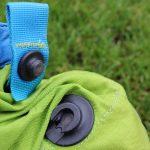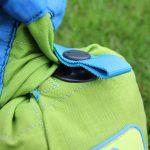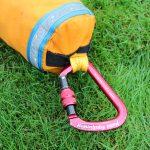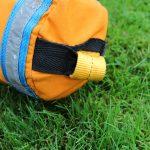One of the very first pieces of paddling equipment that I owned was a Palm 15 metre throwbag that my uncle gave me for Christmas nearly twenty years ago, however, I actually only managed to throw it once in a real rescue. As I threw it into the water I lost my balance, missed the swimmer, dropped the rope and down the river it floated never to be seen again. My rescue skills have certainly come a long way since then, but one piece of equipment that has been steady in my kit bag ever since has been a Palm throwline (I’ve tried all the rest and remained a fan of Palm throwlines for over two decades!) Throwlines are an item of equipment that I just can’t compromise on.

Palm has three different bags which cover a range of options, features and uses for a paddler, they are the Lightning, the Bolt and the Pro series (formerly known as Bullet, Alpine and Canyon). Out of the three bags I’ve used the 20 metre Pro the most and have owned at least three variations of it since it first came out. I’ve used the lightning for the last twelve months and the Bolt for the last couple of months following its recent release.
Before you choose your throwbag you need to ask yourself a few questions
What are you going to use it for?
It might sound like too obvious a question, but depending on your intended use you might choose a different bag.
- Is it primarily going to be used for throwing to a swimmer?
- Will you be possibly lowering/lifting boats down a steep riverbank with it?
- Will you be using it to pull on in a pinned boat situation?
- Will you be using advanced rescue techniques with this rope?
How long or thick do you need the rope to be?
The length and diameter of the rope typically dictate the overall size and weight of the bag. I often see paddlers opting to buy shorter length ropes because they think they might not be able to throw a bigger bag. But you can always remove line quickly from a bag to make it smaller, lighter and easier to throw, and making a shorter rope longer isn’t quite as easy! Thicker ropes are generally easier to handle when they come under load and are also more durable, however, this makes them heavier and not quite so easy to throw. Thinner lines can be tougher to handle when loaded (although good technique can help here) but they are lighter and more compact which makes them better for a bag optimised for throwing.

Closure and clipping
No one wants their throwbag to open accidentally and to dump all of their rope over the floor. We need closures that open quickly only when we want them to and stay securely closed the rest of the time. Both the Lightning and the Bolt use a Fidlock magnetic closure and the Pro throwlines use a shock cord closure. The Fidlock closure, is simple, lightweight and is more secure than a typical press stud closure we see on other manufacturers bags. The shock cord closure is durable, easy to use (even with gloves or cold hands and gives a really secure closure. The best thing to do here would be to try out both closures and see if you have a preference for one or the other.
For some rescues being able to clip a karabiner to the bag end is required. Palm’s Quickclip attachment point makes this super simple and means that you don’t have any rope forming a handle or a loop at the bag end. The Quickclip attachment point is unobtrusive and easy to spot and clip because of the high vis colour, this is a feature I really like on all of the bags.
What to look for in a throwbag
There are some great features that are standard across all of the range of Palm throwlines
- High visibility colours and matching high visibility floating rope
- All the rope has a core for durability and strength
- Length, breaking strength and rope diameter all printed clearly on the outside
- All ropes and throwlines meet the clean line principle (no handles in the rope or large loops at the end of the bag)
- All use a Quickclip attachment point
- All bags can be carried on a waist belt (optional)
Now onto the specific details of the bags
Lightning
Length: 18 metres
Rope diameter: 8 mm
Breaking strength: 8 kN
Weight: 551 g
Price: £34.95
This little throwbag has been in my boat regularly throughout the last twelve months. It’s been in my creek boat, canoe, freestyle boat, on my SUP and gets used regularly by participants on my rescue courses. Due to its smaller size, it is really easy to throw and I can be accurate when sending it to a swimmer, right up to its 18 metre rope length. The rope has proven to be durable and is easy to use, although there have been a few times where I’ve wanted a thicker rope in my hands in a high load situation. On rescue courses, I’ve found that everyone has loved it as it is really quick to pack due to its wide neck which is stiffened by some additional material on the inside.
Pros
More compact and lighter to carry
Great for throwing rescues
Easy to pack bag
Simple and durable construction
Great value
Cons
Thinner rope can make it a bit tricky to handle sometimes
Best uses
Dedicated throwbag
A second bag carried in addition to a thicker line
When space/weight is an issue
Carried by coaches supervising sessions from the bank
A first throwbag
Bolt
Length : 20 metres
Rope diameter : 11 mm
Breaking strength : 10 kN
Weight : 1123 g
Price : £49.95
The Bolt shares many of the design features of the lightning bag, but scaled up by using thicker rope which results in a larger throwline to use/carry. This makes the Bolt a great all-rounder, balancing good handling 11 mm rope contained in a durable and uncomplicated bag with a lightweight and secure closure. I’ve used this bag for lowering boats, pulling on to drag boats out of the river and of course for standard throwline rescues too. Most likely this will become my bag of choice when I’m paddling in a more advanced environment and my rope needs to be more adaptable to a wider range of rescues (it also has reflective detailing which the Lightning bag doesn’t have).
Pros
Good balance of rope diameter and weight
Easy to pack bag
Simple and durable construction
A great all-rounder suitable for a wide range of rescue applications
Cons
A bigger, heavier and more expensive throwline than the Lightning
Best uses
A paddler looking for one bag to do it all
Advanced environments and rescue techniques
Pro throwlines
15 metres, 929 g, £39.95
20 metres, 1168 g, £44.95
25 metres, 1436 g, £49.95
(All bags have 11mm rope with a breaking strength of 10 kN)
Up until the Lightning and the Bolt came along the 20 metre ‘Alpine’ Pro was my go to bag. Solid, durable and dependable, I’ve used this bag for everything, everywhere! With the Pro throwline you have the same style of bag, but in three different rope lengths (with corresponding size and weight).
There are a few features of the Pro throwlines that make them different from the lightning and the bolt however, the first one being the shock cord closure. This is the most secure closure out of all of the bags and is also the most durable, being obvious and easy to use (but also being heavier than the Fidlock.) One feature I do like of the shock cord closure is you can keep the bag partly open which I find is very useful when I use my throwline on a canoe as a swim line. The bag of the Pro throwlines is also super durable and has built in foam floatation so during rescues it does stay on the surface of the water better.
The Pro throwlines are loved by rescue teams and paddlers across the globe, simple, durable and effective.
Pros
A range of length options to suit needs
Durable shock cord closure
Most secure closure if carrying on the waist
Floating bag
Cons
Heavier bags
More expensive when compared to the lightning
Best uses
Dedicated rescue line
Canoe swim line
Waist-mounted carrying (rafters, canoeists etc)
A few final thoughts
I often get asked if Palm throwlines are worth the money and I can wholeheartedly say yes. Palm use top quality materials, premium rope and have attention to detail that you don’t get on many other throwlines. Sure, you can buy cheaper throwlines, but is it worth it? Cheaper throwlines often use lower quality rope (to keep the cost down) which doesn’t have a core, isn’t very strong and doesn’t handle very well. They also won’t have features like the Quickclip and the Fidlock or shock cord closure. The bags can be poorly designed, hard to pack and not very durable. These features really do add up on a throwbag and all help to make it more effective when used properly.
When you buy a Palm bag you can also be assured that a huge amount of R&D has gone into it. These bags have spent hundreds of hours in the hands of the best paddlers in the world in some crazy locations and with international rescue teams depending on them on a daily basis. By the time that bag ends up in your hands you can be certain it’s been tested for real.
As for which bag will I use in the future? I’ll use all three of course!
